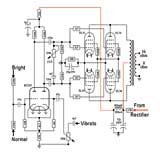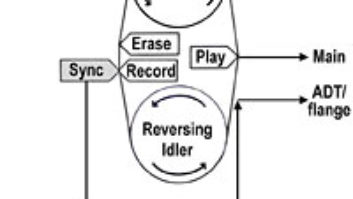
Troubleshooting and mixing have the potential to be long, arduous journeys, but I’ve learned to accept them for their educational value. Mixing taught me to pay more attention before pressing Record, while the service business has many benefits, not the least of which is circuit familiarity. Combine the two and you’ll find yourself at a fork in the road: One path is a mod to record difficult guitars easier, while the other path details just how long the road to a fix can be. The two stories have an output amplifier configuration in common, so let’s rock!
I had never really explored the Vox AC-30 until this year, when Tom Morrongiello, guitar tech on the Bob Dylan tour, requested an emergency visit. The problem manifested itself as a note-specific hypersensitivity that would send the amp into a screaming fit of crunchy static. They gave me four hours to turn the amp around; it didn’t have to be fixed, just diagnosed. Of course, I did my homework first, doing the Google thing and opening up Aspen Pittman’s The Tube Amp Book (www.groovetubes.com) to review the schematic.
Figure 1: Vox AC-30 power amp schematic. Like Tweed-era designs, this amp does not have negative feedback (typically from the speaker output to the ECC83/12AX7 driver stage).
The Vox AC-30 is my kind of amp, having one of the same tone-specific features as the Gibson GA-6, a personal fave. Both models do not have feedback in the output amp (see Fig. 1) and this, I believe, contributes mightily to their character by extending the sweet nonlinear range between clean and clipped. When used in a high-fidelity application, feedback reduces distortion, flattening and broadening the frequency response. But for an instrument amplifier that is likely to be intentionally overloaded, an amp with feedback can make some pretty weird tones. In addition, 20 to 20k Hz bandwidth for a guitar is hardly necessary.
BACKGROUND VOX
Upon arrival, I let my kids “play bass” through the AC-30 during lunch. I was hoping for a clue, but nothing remarkable happened. (They’re usually pretty good about finding the Achilles heel.) Same on the bench — powering a resistor bank — so I proceeded to look for cold solder joints, arced connectors and burned components. To access the underside of the PCB, I removed all of the knobs and pot nuts. A cathode resistor broke loose when touched, so that item was placed on the “make roadworthy” checklist. I also had a hunch that the amp was noise-prone (based on the grounding scheme), but still no needle in the haystack.
The tubes were cycled through a tester, again with nothing remarkable. After reassembly, I did another resistor bank power test and then went back to the speakers. This time, the frequency was slowly swept from low to high at a decent level. This time, it happened! The magic frequency turned out to be 293 Hz, just between an A# and a B.
At first, the Standby switch was suspect, but a quick swap ruled that out. Tapping on the preamp’s tubes yielded surprisingly little until the output tubes — not normally microphonic (in an obvious way) — were pulled a second time. The internal construction didn’t inspire confidence: I could hear a rattle as each one was tapped, some worse than others. I speculated that the tubes were running hot and that the many expansion and contraction cycles had fatigued the structure.
I don’t normally stock the EL84/6BQ5 miniature output tube (it has specs similar to a 6V6) and Yik, the other guitar tech, didn’t have access to his stock, so there was no immediate proof of my theory. I did get to see some of the show (a great band with Dylan on keys) and have been checking up on the amp ever since. After the new tubes were installed, the amp behaved for less than a handful of performances and has had three other “specialists” doting on it. I remembered a guitar amp mod from my Record Plant daze and called Paul Prestopino to confirm.
ODE TO DIE(ODE)
In New York City back in the late ’70s, Michael Guthrie was a technical engineer at the Record Plant and Bearsville Studios. Well-known for his Ampex MM1200 mods, Guthrie also had a guitar amp tweak: a simple diode clamp to protect the output tubes from “transformer reflections,” the type that might occur by plugging or unplugging the speaker while the amp was on and being played. I have a feeling that there may be interactivity issues in the Vox speaker/transformer/output tube combo that might benefit from this mod. Modern speakers, even the retro types, tend to have more efficient magnets and can generate more back EMF as the speaker returns to its at-rest position. The speaker’s free-air resonance, a bad transformer run or wimpy tubes could all be contributors.
SO, WHAT IS IT?
Unfortunately, life on the road continues to generate some of the strangest problems. Yik told me that he used Vox amps on tour from ’92 to ’98 without incident. The problem amp was from 2002, and now, the backup amp (circa ’98) has started to exhibit the same symptoms. I’ll keep you posted.
WHAT IS THAT SOUND?
About 10 years ago, a band asked me to engineer their contribution to a compilation CD, and so I ventured into their basement rehearsal space on New York’s Ludlow Street for pre-production. They were “just” a trio — guitar, bass and drums — doing a speed-metal-reggae kinda thang. The vocalist/bass player was having pitch difficulties. I asked the guitar player (who had, like, eight freakin’ pedals) to lay low in the verse and — voila! — the vocals improved exponentially.
Still, I anticipated problems in the studio because “pedal boy” seemed hell-bent on making lots of dense noise; quite frankly, he was eating up sonic real estate big time and I hate that! (Now do you see why I am a geek and not a full-time engineer?) Back in the lab, I modified my fave old GA-6 Gibson guitar amp so that the guitar player could use his rig while providing me with options.
Figure 2: The modified input section to a Gibson GA-6 guitar amp allows a guitar or bass to feed two destinations at once without loading the instrument.
MOD SQUAD
Figure 2 shows the modified front end of the GA-6 with its 12AY7 dual-triode. Originally designed for two inputs (instrument and mic), one channel and half of the tube were sacrificed for the DI. The top triode was reconfigured as a cathode follower to drive the 10k-ohm side of the transformer, the first gain stage (the lower triode) and a medium-Z (isolated) output for driving pedals. It’s pretty simple.
The guitarist plugs into the instrument input and can take either the hard-wire mult output or the isolated output to drive an amp or pedals. Obviously, the direct output is handy for bass and re-amping.
I prefer the “overdrive” sound of small amps without feedback to pretty much any high-powered amp, and I am all over the option to set the controls the way I like them — generally, with less gritty distortion — without stepping on the musician’s ego.
For more fun, visit Eddie at
www.tangible-technology.com.







